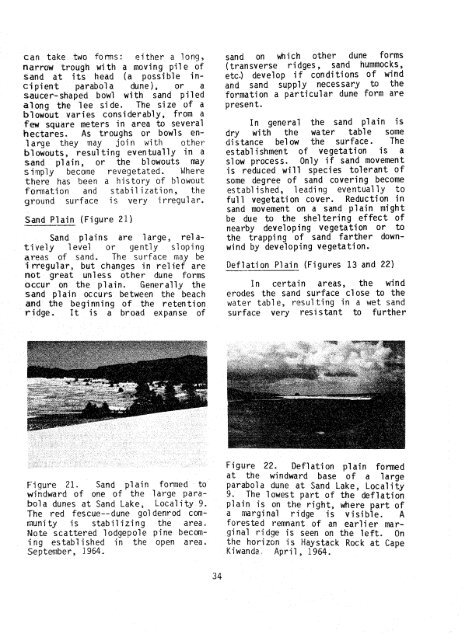The ecology of Pacific Northwest coastal sand dunes
The ecology of Pacific Northwest coastal sand dunes
The ecology of Pacific Northwest coastal sand dunes
Create successful ePaper yourself
Turn your PDF publications into a flip-book with our unique Google optimized e-Paper software.
can take two forms: either a long,<br />
narrow trough with a moving pi1 e <strong>of</strong><br />
<strong>sand</strong> at its head (a possible incipient<br />
parabola dune), or a<br />
saucer- shaped bowl with <strong>sand</strong> pi 1 ed<br />
along the lee side. <strong>The</strong> size <strong>of</strong> a<br />
blowout varies considerably, from a<br />
few square me&ters in area to several<br />
hectares. As troughs or bowls enlarge<br />
they may join wit11 other<br />
blowouts, resu'l ting eventually in a<br />
<strong>sand</strong> plain, or the blowouts may<br />
sirlrply became revegetated. Where<br />
there has been a history <strong>of</strong> blowout<br />
fornation and stabil ization, the<br />
grot~nd surface is very i rregul ar.<br />
Sand Plain (Figure 21)<br />
Sand plains are large, relatively<br />
level or gently sloping<br />
areas <strong>of</strong> <strong>sand</strong>, <strong>The</strong> surface may be<br />
i rregular, but changes in re1 ief are<br />
not great unless other dune forms<br />
occur on the plain. Generally the<br />
<strong>sand</strong> plain occurs between the beach<br />
and the beginning <strong>of</strong> the icetention<br />
ridge. It is a broad expanse <strong>of</strong><br />
<strong>sand</strong> on which other dune forms<br />
(transverse ridges, <strong>sand</strong> hummocks,<br />
etc.) develop if conditions <strong>of</strong> wind<br />
and <strong>sand</strong> supply necessary to the<br />
formati on a particular dune form are<br />
present .<br />
In general the <strong>sand</strong> plain is<br />
dry with the water table some<br />
distance be1 ow the surface. <strong>The</strong><br />
establishment <strong>of</strong> vegetation is a<br />
slow process. Only if <strong>sand</strong> movement<br />
is reduced will species tolerant <strong>of</strong><br />
some degree <strong>of</strong> <strong>sand</strong> covering become<br />
established, leading eventually to<br />
full vegetation cover. Reduction in<br />
<strong>sand</strong> movement on a <strong>sand</strong> plain might<br />
be due to the she1 tering effect <strong>of</strong><br />
nearby developing vegetation or to<br />
the trapping <strong>of</strong> <strong>sand</strong> farther downwind<br />
by developing vegetation.<br />
Deflation Plain (Figures 13 and 22)<br />
--<br />
In certain areas, the wind<br />
erodes the <strong>sand</strong> surface close to the<br />
water table, resulting in a wet <strong>sand</strong><br />
surface very resistant to further<br />
61'gure 21. Sand plain forfiled to<br />
windward <strong>of</strong> orre <strong>of</strong> the large parabola<br />
<strong>dunes</strong> at Sand Lake, Locality 9.<br />
<strong>The</strong> red fescue--dune goldenrod cammunity<br />
is stabilizing the area.<br />
Note scattered lodgepole pine becmiwg<br />
established in the open area.<br />
Septmber , 1954 *<br />
Figure 22, Deflation plain fomd<br />
at the windward base <strong>of</strong> a large<br />
parabola dune at Sand Lake, Locality<br />
9. <strong>The</strong> lowest part <strong>of</strong> the deflation<br />
plafn is on the right, where part <strong>of</strong><br />
a marginal ridge is visible. A<br />
forested remnant <strong>of</strong> an earlier marginal<br />
ridge is seen on the left. On<br />
the horizon is Haystack Rock at Cape<br />
Kiwanda April, 19M.

















